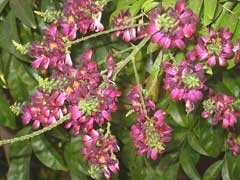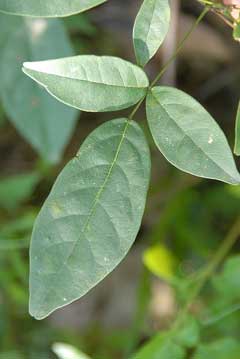 |
|
www.flickr.com/photos/trueepicure/ |
 |
| www.flickr.com/photos/plj/ |
Translate this page:
Summary
Physical Characteristics

 Millettia reticulata is a deciduous Climber growing to 5 m (16ft 5in).
Millettia reticulata is a deciduous Climber growing to 5 m (16ft 5in).
See above for USDA hardiness. It is hardy to UK zone 8. It is in flower from June to August, and the seeds ripen from August to November. The species is hermaphrodite (has both male and female organs) and is pollinated by Insects.
It can fix Nitrogen.
Suitable for: light (sandy), medium (loamy) and heavy (clay) soils and prefers well-drained soil. Suitable pH: mildly acid, neutral and basic (mildly alkaline) soils. It cannot grow in the shade. It prefers moist soil.
UK Hardiness Map
US Hardiness Map
Synonyms
Plant Habitats
Woodland Garden Sunny Edge;
Edible Uses
References More on Edible Uses
Medicinal Uses
Plants For A Future can not take any responsibility for any adverse effects from the use of plants. Always seek advice from a professional before using a plant medicinally.
Emmenagogue Miscellany Oxytoxic Stomachic Tonic
Ji Xue Teng is classified in Chinese herbalism as a plant that invigorates the blood. It is used mainly to treat menstrual problems, relieving pain and normalizing an irregular or absent cycle[254]. The roots and the vines are emmenagogue and stomachic[147]. A decoction is used in the treatment of stomach aches, breathlessness, anaemia in women, menstrual irregularities, vaginal discharge (bloody discharge and leucorrhoea), numbness and paralysis, backache and pain in the knees, seminal emission, gonorrhoea and stomach ache[147, 176]. The plant is used as a tonic to induce the growth of red blood cells[147, 218]. The plant contains the antitumour compound rotenone[218].
References More on Medicinal Uses
The Bookshop: Edible Plant Books
Our Latest books on Perennial Plants For Food Forests and Permaculture Gardens in paperback or digital formats.

Edible Tropical Plants
Food Forest Plants for Hotter Conditions: 250+ Plants For Tropical Food Forests & Permaculture Gardens.
More

Edible Temperate Plants
Plants for Your Food Forest: 500 Plants for Temperate Food Forests & Permaculture Gardens.
More

More Books
PFAF have eight books available in paperback and digital formats. Browse the shop for more information.
Shop Now
Other Uses
References More on Other Uses
Cultivation details
Succeeds in full sun in a fertile moisture-retentive but well-drained soil[200]. This species is not hardy in the colder areas of the country, it tolerates temperatures down to between -5 and -10°c and down to about -15°c when given the protection of a warm sunny wall[200]. This species has a symbiotic relationship with certain soil bacteria, these bacteria form nodules on the roots and fix atmospheric nitrogen. Some of this nitrogen is utilized by the growing plant but some can also be used by other plants growing nearby[200].
References Carbon Farming Information and Carbon Sequestration Information
Temperature Converter
Type a value in the Celsius field to convert the value to Fahrenheit:
Fahrenheit:
The PFAF Bookshop
Plants For A Future have a number of books available in paperback and digital form. Book titles include Edible Plants, Edible Perennials, Edible Trees,Edible Shrubs, Woodland Gardening, and Temperate Food Forest Plants. Our new book is Food Forest Plants For Hotter Conditions (Tropical and Sub-Tropical).
Shop Now
Plant Propagation
Pre-soak the seed for 12 hours in warm water and sow in a greenhouse in spring. When they are large enough to handle, prick the seedlings out into individual pots and grow them on in the greenhouse for at least their first winter. Plant them out into their permanent positions in late spring or early summer, after the last expected frosts. Layering in spring. Cuttings of half-ripe wood with the leaves removed, July/August in moist sand in a frame[200].
Other Names
If available other names are mentioned here
Native Range
TEMPERATE ASIA: China (Anhui Sheng, Fujian Sheng, Guangdong Sheng, Guangxi Zhuangzu Zizhiqu, Hubei Sheng, Hunan Sheng, Jiangsu Sheng, Jiangxi Sheng, Zhejiang Sheng), Hong Kong, Taiwan TROPICAL ASIA: Vietnam (northeast)
Weed Potential
Right plant wrong place. We are currently updating this section.
Please note that a plant may be invasive in one area but may not in your area so it's worth checking.
Conservation Status
IUCN Red List of Threatened Plants Status :

Growth: S = slow M = medium F = fast. Soil: L = light (sandy) M = medium H = heavy (clay). pH: A = acid N = neutral B = basic (alkaline). Shade: F = full shade S = semi-shade N = no shade. Moisture: D = dry M = Moist We = wet Wa = water.
Now available:
Food Forest Plants for Mediterranean Conditions
350+ Perennial Plants For Mediterranean and Drier Food Forests and Permaculture Gardens.
[Paperback and eBook]
This is the third in Plants For A Future's series of plant guides for food forests tailored to
specific climate zones. Following volumes on temperate and tropical ecosystems, this book focuses
on species suited to Mediterranean conditions—regions with hot, dry summers and cool, wet winters,
often facing the added challenge of climate change.
Read More
Expert comment
Author
Benth.
Botanical References
200266
Links / References
For a list of references used on this page please go here
Readers comment
© 2010, Plants For A Future. Plants For A Future is a charitable company limited by guarantee, registered in England and Wales. Charity No. 1057719, Company No. 3204567.